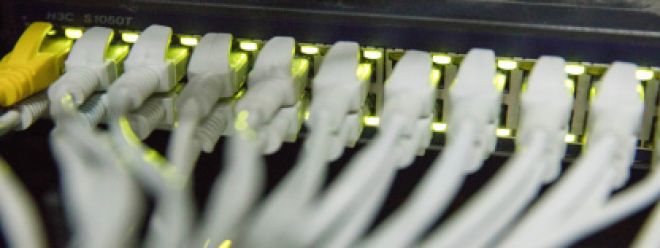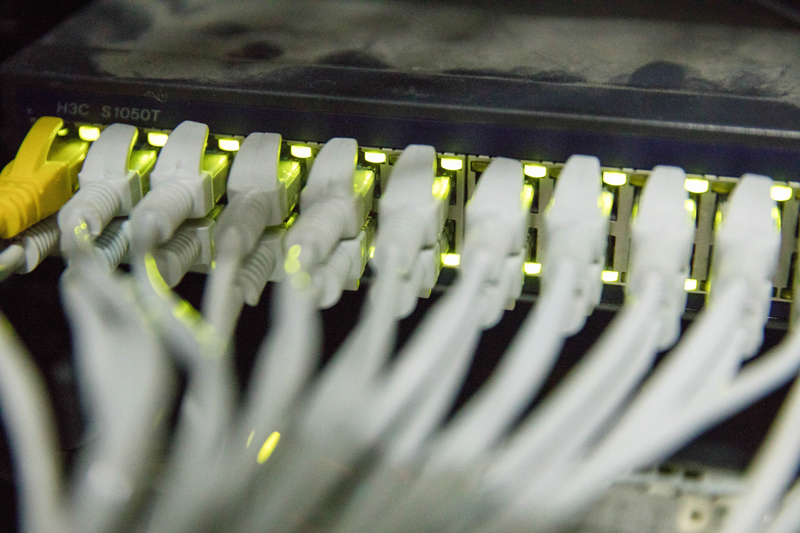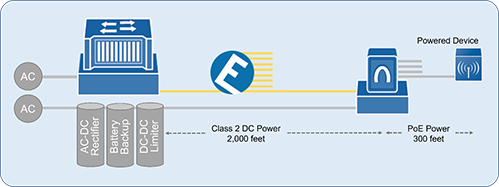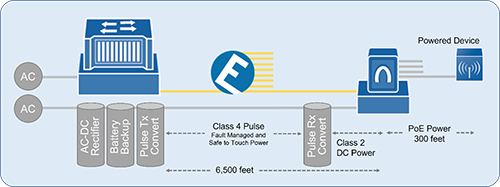Driving Innovation and Unlocking the Unlimited Potential of Optical LANs

Driving Innovation and Unlocking the Unlimited Potential of Optical LANs

It is well known that when connecting smart buildings and the Internet of Things (IoT), there are hard limits related to network power, bandwidth, density and coverage. Electrical signals, whether transmitting power or data, are constrained by physical limitations; in the past, we have only overcome these limitations by making transmission media larger, more rigid, harder to use, shorter and more expensive. These factors have had a severe negative impact on businesses trying to achieve their digital transformation and corporate sustainability goals.
On the plus side, the past decade has led to advances in enterprise networking by prioritizing fiber optic cabling and leveraging passive optical network (PON) designs to optimize the underlying architecture for smart buildings, IoT and sustainability initiatives. Fiber optic cabling has no known bandwidth capacity or connection density limitations. Enterprise-based passive optical local area networks (LANs) have been proven to offer better scalability, security, stability, and sustainability than traditional indoor networks. Relative to coverage, these passive networks can provide Ethernet connectivity over a distance of 12 miles over a reliable infrastructure, without power and with limited human contact.
So far, power challenges have proven more difficult to overcome, especially those related to smart buildings and IoT connectivity needs. However, with continuous innovation and improved methods of powering enterprise connections, the benefits of fiber-optic LANs can now be fully optimized [as shown in Figure 1]. These new forward-looking power methods can be used to achieve scalability, such as Power over Ethernet, Class 2 remote power, Class 4 pulsed power, and direct current (DC) microgrids, freeing them from the constraints of passive optical LANs.
 Driving Innovation and Unlocking the Unlimited Potential of Optical LANs
Driving Innovation and Unlocking the Unlimited Potential of Optical LANs
Figure 1: Passive optical LAN connecting Ethernet endpoints 12 miles away
Power over Ethernet (PoE) allows network cables to transmit power, enabling devices such as smart buildings and IoT devices to be powered and connected over the same Ethernet cable. This eliminates the need for a separate power cord, simplifying installation and reducing costs.
The first is the PoE standard (IEEE 802.3af), which allows 15.4 watts of power, and the second is the PoE+ standard (IEEE 802.3at), which provides up to 30 watts of power to powered devices (PDs). The latest PoE standard (IEEE 802.3bt) can deliver up to 60W (Class 3) or 90W (Class 4) to the PD. PoE is an effective way to power and connect PDs, but its range is limited by the distance Ethernet signals can travel (300 feet).
Optical LAN architectures help extend PoE coverage because the Ethernet port on the optical media converter (called an optical network terminal (ONT)) typically supports all versions of PoE. PoE-enabled ONTs can provide these different levels of more managed PD power (eg, 15W, 30W, 60W, 90W) over a passive network connection of up to 12 miles . PoE over optical LAN improves power delivery by 13% by shortening the transmission distance of PoE and using shorter CATx patch cables between ONT and PD.
The remote power supply system can adopt distributed or centralized design. Distributed remote power is typically located in zone distribution boxes and can be powered from DC in the main data room. Centralized remote power is consolidated in the main data room, where local power distribution units supply power to the PDs. Their DC voltage range is 48V to 54V. These systems can extend the fiber LAN ONT coverage from 300 feet to 2000 feet depending on the copper wire used and the required wattage [as shown in Figure 2].
 Driving Innovation and Unlocking the Unlimited Potential of Optical LANs
Driving Innovation and Unlocking the Unlimited Potential of Optical LANs
Figure 2: Optical LAN using Class 2 to connect ONTs 2000 feet away
Class4 power supply system
Class 4, also known as Fault Managed Power (FMP), is the latest power supply technology defined by standards set by the NEC. It can safely deliver higher voltages better than other classes of circuits because of their added safeguards for monitoring and fault management. In addition, Class 4 has a wider range because it can safely and reliably power devices such as sensors, cameras, wireless access points, fiber optic LAN ONTs, and other long-distance IoT devices.
The Class 4 FMP's innovations are its touch-safe and intelligent pulse power, which delivers energy over time. This is achieved by using a specialized power supply that delivers energy in short bursts, typically less than a millisecond in duration. These energy pulses work in conjunction with voltage limiting (450 Vdc line-to-line or 225 Vdc line-to-ground) and power shutdown (within 5 seconds after a fault occurs) based on the detection of a fault condition, such as contact with human skin.
Class 4 FMP power delivery is an important technology for modern connectivity as it provides a safe and reliable way to power energy-hungry devices over longer distances. Additionally, these systems can help minimize IoT network copper cabling and overall power consumption, making them an important technology for sustainable and energy-efficient buildings. Even better, these Category 4 power delivery systems deliver up to 600W per copper pair over a distance of 6500 feet, such as a fiber optic LAN ONT [pictured below] that can be located a mile away via passive network infrastructure.
 Driving Innovation and Unlocking the Unlimited Potential of Optical LANs
Driving Innovation and Unlocking the Unlimited Potential of Optical LANs
Figure 3: Powering ONT , Class 4 optical LAN up to 6500 feet
DC Microgrid
DC microgrids are an efficient way to power smart buildings and IoT networks, with advantages such as energy efficiency, scalability, and flexibility to integrate with renewable energy sources, which fit perfectly with optical LAN attributes.
One of the advantages of a DC microgrid is that it eliminates the need for AC to DC conversion, which is required for many IoT devices such as sensors, cameras, and other low-power devices. This removes the inefficiencies and penalties associated with transitions, which can be severe when dealing with large numbers of devices.
Another advantage of DC microgrids is that they can be easily integrated with renewable energy sources such as solar panels and wind turbines that produce direct current. This makes them ideal for sustainable and energy-efficient modern buildings.
DC microgrids can be in different configurations such as centralized, decentralized or hybrid. In a centralized configuration, a single DC power supply powers all devices on the network. In a decentralized configuration, each device is equipped with its own DC power source, such as a battery or solar panel. Hybrid configurations combine centralized and decentralized systems to achieve the best of both worlds. DC microgrids are an effective way to power smart buildings and IoT networks, with advantages such as energy efficiency, scalability, and flexibility for integration with renewable energy sources, which fit well with optical LAN properties.
LANs reduce the network attack surface by significantly reducing the number of full-featured switches, user management access ports, IP addresses, IT personnel contacts, door locks, and telecommunications rooms, enabling longer network uptime over optical LANs. This is because optical LANs use passive optical splitters instead of active components, reducing the risk of network downtime. Another advantage of fiber optic LAN is that it requires less human touch to operate. Since human error is the most common cause of network outages, fiber optic LANs can provide a more reliable network while requiring fewer IT and network staff.
The move to fiber optics and the limitations of copper cables are more environmentally friendly than traditional networks. Fiber-optic LANs require fewer power-consuming components than traditional copper-based networks, resulting in significantly lower energy consumption and a smaller carbon footprint. Additionally, fiber optic cables are more durable and last longer than copper cables, reducing the need for replacement and reducing waste. All of this helps companies more easily reach their net zero goals.
In summary, optical LANs offer several advantages over traditional copper-based LANs for connecting smart buildings and IoT devices using fiber optics. Fiber-optic LANs are more secure due to the inherent security features of fiber-optic cables, and the use of passive components minimizes the risk of unauthorized access or network downtime. Optical LANs can scale connection density, bandwidth capacity, and distance. Finally, OLANs are more sustainable and environmentally friendly, requiring fewer power-hungry components and promoting efficient use of resources.
PoE, Class 2 power delivery, microgrids, Class 4 power delivery and passive optical LAN are likely to be increasingly important technologies for modern connectivity as the demand for energy efficient and sustainable buildings continues to grow. In fact, building and campus-wide networks that leverage these technologies in combination will reap the greatest benefits in terms of energy efficiency and sustainability. The perfect combination of these fiber optic cabling, optical LAN and power delivery system innovations will enable future unfettered digital transformation, smart buildings and IoT scalability.